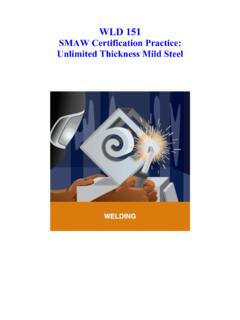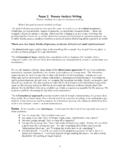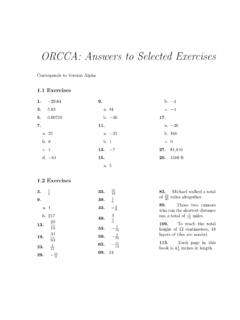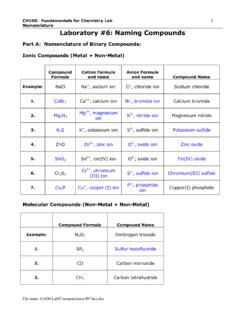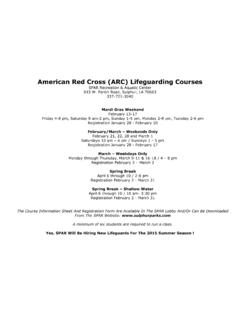Transcription of Lifeguarding Review Questions - PCC
1 1 Lifeguarding Review Questions Optional Review Questions are provided as an additional resource for american Red cross Lifeguarding instructors to help reinforce the learning objectives of the Lifeguarding , Waterfront Lifeguarding , Waterpark Lifeguarding and Shallow Water Attendant courses. There are multiple Review Questions in a variety of formats, such as true and false, fill-in-the-blank, multiple choice and matching, to support the chapters in american Red cross Lifeguarding manual. This helpful resource can be used at the end of lessons, at the end of the course, with a Review course or as a refresher during in-service trainings or between certification periods.
2 Review Questions are provided in MS Word format which can be easily modified. Instructors that choose to use them may select the Questions that fit their teaching needs and help reinforce the objectives of the course they are conducting. The Review Questions for participants are for use by participants and include only the Questions . The Review Questions for instructors are an instructor resource that includes the Questions as well as the answers. The Review Questions are optional and DO NOT replace the final written exam that participants must take for certification.
3 They are provided as additional resources, not to be used for certification purposes. Participant ( Review Questions ) Chapter 1- The Professional Lifeguard Chapter 2- Injury Prevention and Facility Safety Chapter 3- Patron Surveillance Chapter 4- Emergency Preparation Chapter 5- Rescue Skills Chapter 6- Before Providing Care and Victim Assessment Chapter 7- Breathing Emergencies Chapter 8- Cardiac Emergencies Chapter 9- First Aid Chapter 10- The Benefits of Lifeguarding Instructor ( Questions and Answers)
4 Chapter 1- The Professional Lifeguard Chapter 2- Injury Prevention and Facility Safety Chapter 3- Patron Surveillance Chapter 4- Emergency Preparation Chapter 5- Rescue Skills Chapter 6- Before Providing Care and Victim Assessment Chapter 7- Breathing Emergencies Chapter 8- Cardiac Emergencies Chapter 9- First Aid Chapter 10- The Benefits of Lifeguarding 2 Lifeguarding Review Questions CHAPTER 1: THE PROFESSIONAL LIFEGUARD Multiple Choice Circle the correct answer to the question . 1. The F in the FIND decision-making model stands for a.
5 Features of Lifeguarding . b. Figure out the problem. c. Find the problem. d. Focus on Lifeguarding . 2. Good Samaritan laws are designed to protect most professional rescuers from a. The risk of legal action as a result of sharing information about the victim with bystanders and local media. b. The risk of legal action as long as they act in good faith, within the scope of their training and are not negligent. c. The need to legally document what was seen, heard and done at the scene. d. The need to obtain consent before providing care.
6 3. Before providing care for a conscious injured or ill victim, you must first a. Announce to bystanders what you are going to do. b. Begin to write your record of what happened. c. Find out if you have a duty to act. d. Obtain the victim s consent. 4. Which of the following is NOT a responsibility of lifeguards? a. Educating patrons about facility rules and regulations. b. Ensuring the victim returns to his or her previous state of health. c. Minimizing or eliminating hazardous situations or behaviors.
7 D. Providing needed care for the victim. 5. Which of the following personal characteristics should be true of a professional lifeguard? a. Eat and hydrate properly only on days when you are working. b. Maintain a professional attitude, appearance and healthy lifestyle. c. Update certifications within a year after they expire. 3 d. Use sun protection and sunglasses only on hot, sunny days. 6. If a victim of injury or illness refuses care, you should a. Continue to provide care as needed. b. Explain to the victim why he or she needs care and request the victim to at least allow someone more highly trained, such as EMS personnel, to evaluate the situation.
8 C. Interview bystanders and fill out the incident report. d. Tell the victim you are trained to help, your level of training and what you think may be wrong. 7. Negligence includes all of the following EXCEPT a. Failing to control or stop any behaviors that could result in further harm or injury. b. Failing to provide care. c. Providing inappropriate care. d. Providing the standard of care. Matching 8. Match each term with the correct definition. A. Abandonment B. Confidentiality C. Duty to Act D. Negligence E.
9 Standard of Care Legal responsibility to act in an emergency while on the job. The victim s right to privacy, which is protected by not sharing information learned about the victim. Guidelines and expectations for professional rescuers, which may be established in part by their training program and in part by state or local authorities. A failure to follow the standard of care or failure to act, which results in someone being injured or causes further harm to the victim.
10 Leaving the scene of an emergency or ceasing to provide care for a victim who requires ongoing care before someone with equal or greater training arrives and takes over. Multiple Answers Place a check next to the correct answer or answers. 9. To look professional and be prepared to respond appropriately to any situation, a professional lifeguard must 4 Wear the lifeguard uniform when on and off duty. Be well groomed. Keep rescue equipment locked in the storage room so it is ready for use when on duty.

